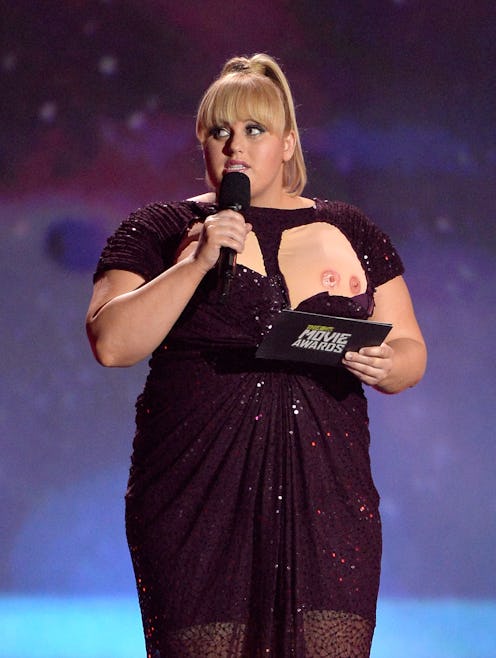News
Why Feminism Needs Nipples
With the release of their controversial front-page nipple image, the New York Times has managed to titillate and enrage the always-prim-and-proper Internet. While there are many things wrong with both the photo and its commentators, I want to move past the out reaches of the areola and get to the center of the issue — the nipple. While the photo shocked some, I think a discussion of how America views nipples attached to those who identify as female has been a long time coming. So let's get mammary.
Nipples and the media already have a contentious relationship at best. The MPAA rating system was recently called out for its inherent sexist biases in slapping an NC-17 on Blue Is the Warmest Color, but, on the issue of nipple exposure, they have a long history of discrimination. The censorship of nudity in film began with the infamous Motion Picture Production Code, or "Hays Code," which was created by a network of Catholic and Protestant officials who wanted to keep film upright and pure, while stemming the tide of "smut" starring such notable hussies as Mae West.
The "Code" included a list of "thou shalt nots," which included some reasonable warnings, such as "children's sex organs" and "willful offense to any nation, race or creed." It also included some horribly damaging racist interdictions, such as "white slavery" and "miscegenation" (sexual relationships between people of different racial backgrounds). The nipple debacle began, though, with the Code's ban on "any licentious or suggestive nudity — in fact or in silhouette; and any lecherous or licentious notice thereof by other characters in the picture." When the Code was put into action in 1934, the war on nipples began.
Over the next 30 years, films would break the Code, eventually leading to its demise, and the production of such thoughtful portrayals of nipples as Wedding Crashers: Uncorked Edition. Since then, Hollywood (and the rest of America) have somehow decided to erase female nipples, while somehow managing to objectify them as purely sex toys. In the aforementioned version of Wedding Crashers, the opening sequence shows bare breasts as a kind of trophy, timing their appearances to the "shouts" in the song "Shout" perfectly. And, of course, the appearance of nipples only occurs just before a sex scene, solidifying some sort of impenetrable bond between nipples and intercourse.
This hyper-sexual view of the female nipple has had real-word consequences. Breastfeeding advocates have long bemoaned society's inability to leave breastfeeding women alone, whether they are in a public space or promoting their cause on social media. I choose to remain neutral in the battle over the practice itself (since I am not a mother), but I still feel it is unfair to discriminate against women who are using their nipples since we have built them up as the penultimate sexual body part. I feel the same way about the sexualization of breast cancer survivors, which is why the flirty framing surrounding the discussion of the New York Times picture of a survivor is so troubling.
Equally problematic is the erasure of areolae in many types of media. Most recently, I wondered if Kim Kardashian is some sort of nipple-free wizard in the "Bound 2" video. While I don't want to contribute to the buzz surrounding such a corny and mediocre music video, I am surprised that few people have mentioned Kim's apparent lack of areolae. And then I remember that Victoria's Secret has been using photoshop to chop the nipples off their models for years, and I remember that nipple erasure in modern media is just as common as nipple hyper-sexualization.
And this brings use to the common nip slip, which is also a major component in the general nipple debacle. Female celebrities are expected to "look hot" for awards shows, which often include tasteful sideboob, cleavage, innerboob, and underboob. Yet whenever their flimsy red carpet armor fails, we all gasp, or worse, laugh. Rebel Wilson famously goofed on this phenomenon at the MTV Movie Awards this year, where she revealed a fake "double nip slip," which prompted laughs as well suggestions that she was being "too edgy." Of all the poor judgements made at award shows this year, I don't think forcing the audience to confront their opinions on wardrobe malfunctions even makes the top ten.
I think that these ridiculous nipple-politics show an underlying trend, in which the entertainment (and media) industry expect women to somehow show "just enough" boob without ever exposing the all-powerful nipple. The New York Times photo, with its strip-tease feel, reinforces this impossible paradigm, and the media's response to it re-objectifies something that has been separated from any sort of humanity for years.
So the next time you hear about nipples (and face it, we all will eventually), think about the fact that they are attached to real, complex, human women. The next time you see a breast in a magazine or on TV devoid of its appropriate nipple, think about the reasons Americans are so afraid of such a small body part. Also consider the fact that they have numerous uses and problems, some of which are decidedly unsexy. We cannot beat the onslaught of hyper-sexualization yet, but we can try.
